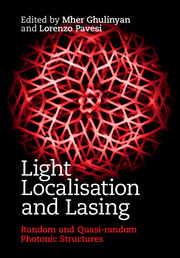Book contents
- Frontmatter
- Contents
- List of contributors
- Preface
- 1 Light propagation and emission in complex photonic media
- 2 Transport of localized waves via modes and channels
- 3 Modes structure and interaction in random lasers
- 4 Ordered and disordered light transport in coupled microring resonators
- 5 One-dimensional photonic quasicrystals
- 6 2D pseudo-random and deterministic aperiodic lasers
- 7 Three-dimensional photonic quasicrystals and deterministic aperiodic structures
- 8 Cavity quantum electrodynamics with three-dimensional photonic band gap crystals
- References
- Index
5 - One-dimensional photonic quasicrystals
Published online by Cambridge University Press: 18 December 2014
- Frontmatter
- Contents
- List of contributors
- Preface
- 1 Light propagation and emission in complex photonic media
- 2 Transport of localized waves via modes and channels
- 3 Modes structure and interaction in random lasers
- 4 Ordered and disordered light transport in coupled microring resonators
- 5 One-dimensional photonic quasicrystals
- 6 2D pseudo-random and deterministic aperiodic lasers
- 7 Three-dimensional photonic quasicrystals and deterministic aperiodic structures
- 8 Cavity quantum electrodynamics with three-dimensional photonic band gap crystals
- References
- Index
Summary
Introduction
Self-organization is one of the most extraordinary tools in Nature which assembles its elementary building blocks, atoms and molecules, in the form of solid substances. Crystals, in this sense, represent the class of a vast number of solid materials in which atoms (molecules) are brought together in a perfect, spatially periodic manner. A macroscopic crystal, therefore, is made by repeating its smallest microscopic period – the crystal unit cell – infinitely in space (Fig. 5.1(a)). Therefore, when translating the crystal by an integer number of unit cell size, the crystal coincides with itself. This property is in the basis of modern solid-state physics and crystallography and is known as the discrete translational symmetry. Crystals are thus ordered materials in which atoms show both short- (within a couple of nearest neighbors) and long-range order. Because of the periodic lattice potential, the energy states within a crystal are extended, and the electrons can diffuse freely through it.
At the opposite extreme of crystalline order there are the disordered or amorphous solid materials, in which the short-range order may still exist, while the long-range order is completely missing (Fig. 5.1(c)). In these kind of solids, e.g. in heavily doped semiconductors or glasses, periodicity is lacking and the atomic potential varies in a random manner. In certain cases, when the degree of randomness is large enough, electron wavefunctions localize exponentially near individual atomic sites and the diffusion of charge carriers vanishes (Anderson localization) [11].
With the advances in X-ray diffraction tools at the beginning of the twentieth century, scientists learned to image the signatures of long-range order of crystals by mapping the symmetries of their reciprocal space lattices. The crystal symmetries for all possible arrangements of perfect periodicity are classified in 230 space groups. Contrary to this, the diffraction form, a disordered solid, shows cloud-like concentric rings indicating diffraction from a totally random atomic lattice and, consequently, a lack of any symmetry or, equivalently, any preferential direction in the solid.
- Type
- Chapter
- Information
- Light Localisation and LasingRandom and Pseudo-random Photonic Structures, pp. 99 - 129Publisher: Cambridge University PressPrint publication year: 2014
- 1
- Cited by



